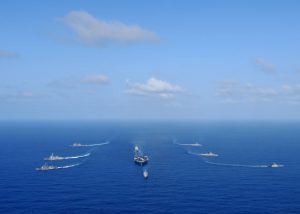The Hindu reported on October 30 that this year’s India-Japan-United States Malabar naval exercise, which will also see the participation of Australia for the first time in 13 years, will be held in two phases. From November 3 to 6, as the first phase the exercise will take place off the coast of Vishakhapatnam in the Bay of Bengal, while the second phase will take place between November 17 and 20 in the Arabian Sea.
According to the report, in the first phase of the exercise, the United States Navy will field USS John S McCain, an Arleigh Burke-class destroyer that resumed operations in June this year after an accident in 2017 that killed 10 sailors, while the Royal Australian Navy will be represented by the Anzac-class HMAS Ballarat frigate. (A video clip posted by the Australian Department of Defense on Twitter shows the U.S. destroyer and Australian frigate setting course for the Malabar exercise.) The Japanese Maritime Self Defense Force will send JS Onami, a destroyer. The Indian Navy will be represented by a destroyer, a stealth frigate, an offshore patrol vessel, a fleet support ship, and a submarine, along with P-8I and Dornier maritime surveillance aircraft, an advanced trainer jet, and helicopters, the Hindu report adds.
While this year’s Malabar exercise is formally independent of the Australia-India-Japan-United States Quad consultation mechanisms, Australia’s presence effectively makes it connected. What adds significant signaling value to the exercise is that it sits on top of an array of political and military dialogues and arrangements between the four countries. After the announcement on October 19 that India will invite Australia to the exercise, I had written:
The four nations have also significantly expanded their defense ties bilaterally, while coordinating their positions on regional issues as a group, and through trilaterals, sometimes involving other countries. India already has military logistics agreements with all three of the other Quad members. To this increasingly dense mesh of relationships now lies added a renewed four-nation military exercise.
The Indian navy has held passage exercises (PASSEX) with all three countries over the past few months. In July, Indian warships joined the aircraft carrier USS Nimitz and its associated strike group for a PASSEX off the coast of the strategic Andaman and Nicobar Islands in the western Indian Ocean. A news report suggested that the Indian Navy again was scheduled to hold another PASSEX on October 12 with aircraft carrier USS Ronald Reagan off the coast of Kochi on the Arabian Sea. However, there is no confirmation about whether that took place.
Some Indian experts have already pointed out that judging by the assets fielded by Australia, Japan, and the United States, the first phase of this year’s Malabar exercise looks mundane. Retired Indian Navy Commodore Venugopal Vengalil tweeted that a “more credible line up is required to send the right message to China if that is the intent.” Past editions of the Malabar exercise have been extremely sophisticated, with a pronounced focus on anti-submarine warfare (ASW) in the past.
Last year, the Malabar exercise took place off the coast of Japan. At that time, the United States had fielded a Los Angeles-class nuclear-propelled attack submarine (SSN) along with a destroyer and a P-8A maritime surveillance aircraft. In fact, last year’s Malabar saw India field a P-8I aircraft as well, while Japan’s navy included a Kawasaki P-1 maritime surveillance aircraft – platforms crucial for ASW operations. Given that the Australia has owned P-8A planes since 2016, this year’s Malabar could have been the perfect opportunity for all four to jointly show off their ASW chops. The picture becomes even more muddled when one considers the fact that last year’s bilateral Australia-India naval exercise had a strong ASW component, where Australia had sent a P-8A aircraft.

































